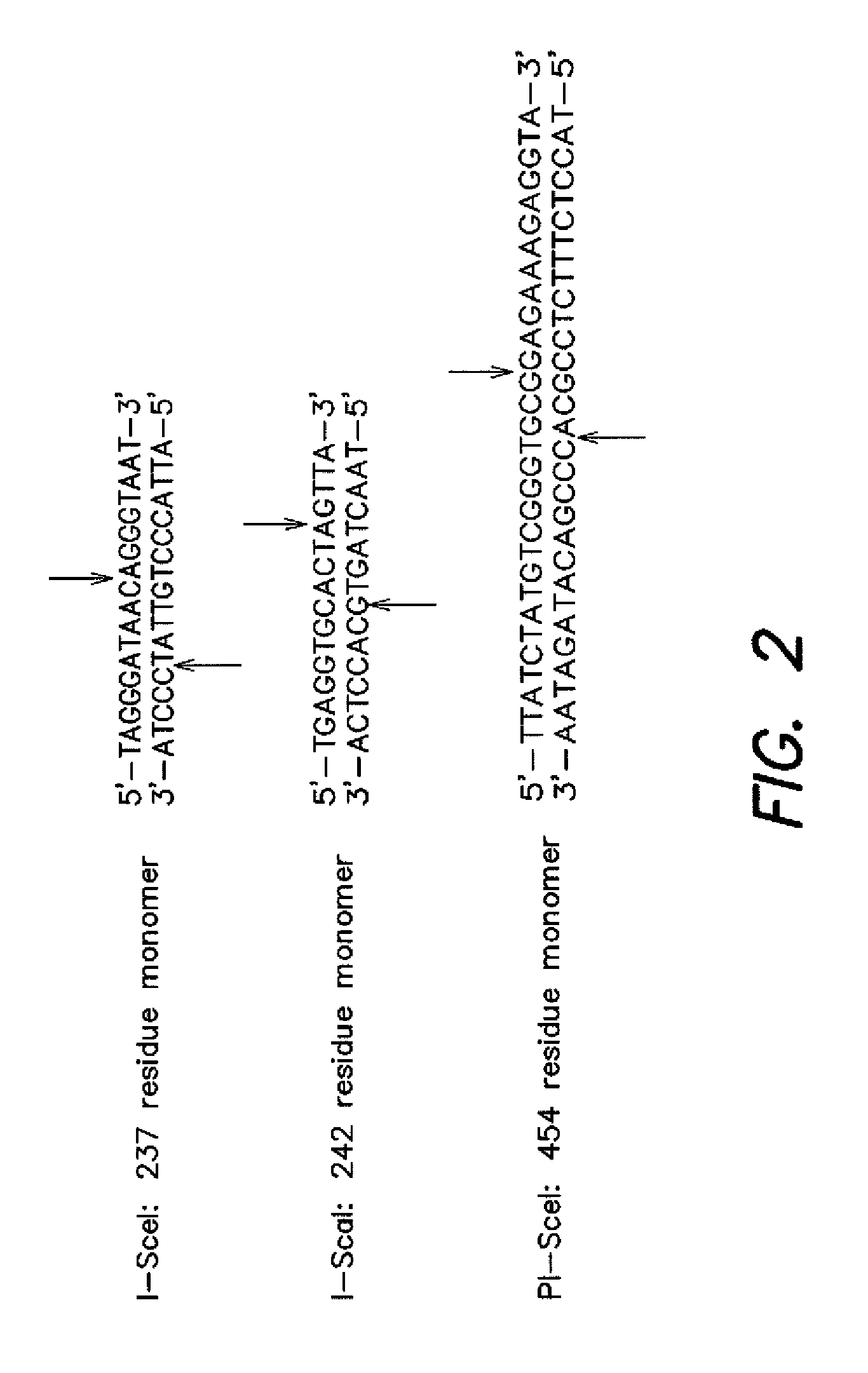In vivo selection system for enzyme activity
a selection system and enzyme technology, applied in the field of in vivo selection system for enzyme activity, can solve the problems of limited scope of protein molecular evolution, limited potential diversity of proteins explored by in vivo selection, and difficult rational design of enzymes with novel activities
- Summary
- Abstract
- Description
- Claims
- Application Information
AI Technical Summary
Benefits of technology
Problems solved by technology
Method used
Image
Examples
example 1
An In Vivo Selection System for Homing Endonuclease Activity
[0091]As discussed above, the present invention provides a novel in vivo system for selective cells having a homing endonuclease activity.
[0092]Development of a Conditionally Toxic Homing Endonuclease Substrate: Non-native DNA cleavage is typically detrimental to living cells. In order to transform DNA cleavage into an event necessary for cell survival, the ability of homing endonucleases to transform circular plasmid DNA into linear products was utilized. Since linear DNA does not replicate efficiently in E. coli and is rapidly degraded by the endogenous RecBCD nuclease (Kuzrninov et al. J. Bacteriol 1997, 179, 880-888), it was hypothesized that endonuclease-catalyzed cleavage of a plasmid encoding a toxic protein could rescue the ability of cells to survive under suitably controlled growth conditions.
[0093]The first requirement of implementing this strategy is “caging” the toxicity of a toxic gene so that it will not kill...
example 2
An In Vivo Selection System for Recombinase Activity
[0111]Initial efforts to link cell survival with recombinase activity focused on Cre recombinase and its 34 base pair loxP substrate. It was hypothesized that recombination could be positively linked to cell survival by either (i) flanking a gene encoding a toxic protein by loxP sites, or (ii) disrupting an essential gene with an intervening segment of “junk DNA” flanked by loxP sites (FIG. 4). In the former case, recombination excises the toxic gene from the plasmid, rendering the plasmid non-toxic. Because nearly all copies of the toxic gene may need to be removed in order for the cells to be viable, this scheme represents a stringent selection. In the latter case, recombination rejoins two halves of an essential gene, allowing the cell to survive. Since only a small number of copies of the recombined essential gene may be sufficient to confer survival, this strategy may serve as a more sensitive and less stringent selection. We ...
example 3
An In Vivo Selection System for Intein Activity
[0119]Several of the concepts described above have been applied to efforts to develop an in vivo selection for intein activity. Among the growing collection of inteins studied, the M. tuberculosis RecA intein is particularly attractive because of its small size, ability to splice efficiently, and well-characterized in vitro and in vivo properties (K. V. Mills et al. J. Biol. Chem. 2001, 276, 10832-8; K. Shingledecker, et al. Arch. BioChem. Biophys. 2000, 375, 138-44; B. M. Lew, et al. J. Biol. Chem. 1998, 273, 15887-90; K. V. Mills, et al. Proc. Natl. Acad. Sci. USA 1998, 95, 3543-8). We hypothesized that protein splicing activity could be linked to cell survival by disrupting an essential gene with the RecA intein. Only cells harboring active inteins would be able to generate the essential protein in the active form required for cell viability. For the reasons discussed above, the use of an antibiotic resistance gene was chosen, rather...
PUM
 Login to View More
Login to View More Abstract
Description
Claims
Application Information
 Login to View More
Login to View More - R&D
- Intellectual Property
- Life Sciences
- Materials
- Tech Scout
- Unparalleled Data Quality
- Higher Quality Content
- 60% Fewer Hallucinations
Browse by: Latest US Patents, China's latest patents, Technical Efficacy Thesaurus, Application Domain, Technology Topic, Popular Technical Reports.
© 2025 PatSnap. All rights reserved.Legal|Privacy policy|Modern Slavery Act Transparency Statement|Sitemap|About US| Contact US: help@patsnap.com



